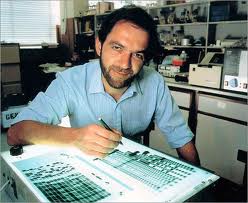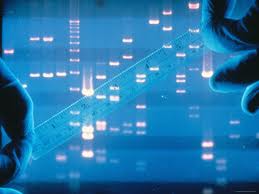Innovations
PCR
Scientists were attempting to find a way to create many copies of DNA for use in the lab, and Mullis was the one who came up with the idea of using the natural cycle of Polymerase Chain Reaction (PCR) to do so. The process of PCR begins with heating up the targeted piece of DNA at 95˚C in order to denature it into two separate strands. At 65˚C or so, the primer anneals to the DNA strands, and at 72˚C the DNA polymerase enzyme pairs up nucleotides with the template. Forty-five minutes and many cycles later, at least a million copies of DNA have been produced, sometimes from such a small source as a drop of blood. Scientists nowadays use PCR machines that regulate the temperature and timing. The process of PCR is widespread and used to amplify DNA in order for it to be visible in an electrophoresis gel for such applications as those described below.[3] The following video accurately portrays the process PCR. The accompanying music is irrelevant, so feel free to watch the video with the sound off.
Genetic Fingerprinting
While researching myoglobin, Jeffreys (shown to the left analyzing a gel) noticed a genetic sequence that repeated several times. Looking at the rest of the genome, Jeffreys discovered similar areas of repetition. When he used a probe on one of the sequences in several different people's DNA and performed gel electrophoresis, he noticed that each individual had a different fragment length. He named the bands restriction length fragment polymorphisms (RFLPs). With the knowledge that all humans had the same sites and sequence of repetitions as well as varied amounts of repetitions, Jeffreys realized that his discovery would be useful in identifying individuals and proving relationships. When he published his paper in Nature magazine, he referred to the combination of an individual's RFLPs as his or her DNA "fingerprint." [7]
The first case Jeffreys solved with DNA profiling was that of a mother's relationship with her son. Andrew Sarbah was not allowed to enter England and reunite with his mother unless it could be proven that he was her son. Jeffreys took genetic fingerprints of Andrew, his mom, his siblings, and a few other relatives. Knowing that children receive one set of alleles from each of their parents, he had to show that half of Andrew's alleles came from his mom and not someone else. The data from the genetic fingerprints showed that Andrew was definitely his mother's son, and the case against him was dropped. [7]
A few years after Jeffreys' discovery, a more exact method of DNA fingerprinting was developed. Variable number of tandem repeats (VNTRs) loci are areas in the genome where a sequence of approximately 11-60 nucleotides are repeated. A VNTR has recognition sequences for restriction enzymes on either side of its locus, so it can be easily removed and analyzed for repeat length via electrophoresis. When there are more alleles for a repeat (i.e when many variations of amounts of repeats exist for a given locus), the probability that another individual has the same alleles is less. Combining several VNTR loci with such properties results in a better fingerprint for an individual - a greater chance that the genetic fingerprint is unique to that person and won't be shared by anyone else in the world. [14]

In the early 1990s, several scientists thought to use even larger amounts of repeat variability by reducing the sequence to be repeated. They cut down the sequence to 2-5 base pairs which became known as short tandem repeats (STRs). (nal.usd.gov) There are many possibilities for STRs to be used in genetic fingerprints, but scientists and/or government agencies choose certain loci for their high rates of polymorphism. Different agencies choose different loci for whatever reason: the U.S. FBI's chosen 13 loci slightly differs from the U.K.'s eleven loci which lack some of the Extended European States' 12-17 STR loci. [8]
This image shows a scientist analyzing a genetic fingerprint(s)
MtDNA
Mitochondrial DNA (MtDNA) is the DNA found in a cell's mitochondria. The DNA used for RFLPs, VNTRs, and STRs is located in the nucleus. Since there are many mitochondria in a cell, as opposed to only one nucleus, there is much more DNA that can be recovered from mitochondria. When a source of DNA (e.g. teeth, blood, hair, etc.) has degraded (as a result of time, fire, etc.), evidence gathered from its nuclear DNA can be unreliable or dysfunctional. Therefore, mtDNA is used for genetically fingerprinting a deteriorated source of DNA. The catch is that mtDNA is not unique to an individual. Mitochondrial DNA is passed on by the mother, so many family members will have the same mtDNA. On the other hand, this inheritance pattern allows relatives to be easily identified, which is how mtDNA is used to identify otherwise unidentifiable remains (such as those left over by the 9/11 terrorist attack). [3][10]
CODIS
The FBI began the Combined DNA Index System (CODIS) after witnessing the various successes of genetic profiling and its usefulness in solving crimes. At first, CODIS was only used by nine states, but now all fifty states participate in it. Many labs around the country take part in CODIS by producing genetic fingerprints of evidence and suspected persons through PCR amplification of STRs. The FBI has identified thirteen loci of STRs to use as a standard when fingerprinting in order to have unequivocal proof of the match of a genetic fingerprint with an individual. There remains the possibility of more loci being added to the ones used by the FBI so that DNA fingerprints could reliably be used internationally and create even greater accuracy. [10]
The Innocence Project
Barry Scheck and Peter Neufield, later responsible for O.J. Simpson's release, realized the new technology's potential in exonerating wrongly convicted prisoners. Thus, they decided to found the Innocence Project, whose mission is "nothing less than to free the staggering numbers of innocent people who remain incarcerated and to bring substantive reform to the system responsible for their unjust imprisonment." The Innocence Project's website, http://www.innocenceproject.org, lists several ways people can be declared guilty mistakenly. The website also mentions the reasons DNA fingerprinting is a more reliable source of evidence than other methods of forensics are. It uses the evidence kept from past cases by taking DNA fingerprints from the evidence and the accused, then comparing the resulting profiles. If the profiles don't match, the accused must be innocent of the crime and released. [12]